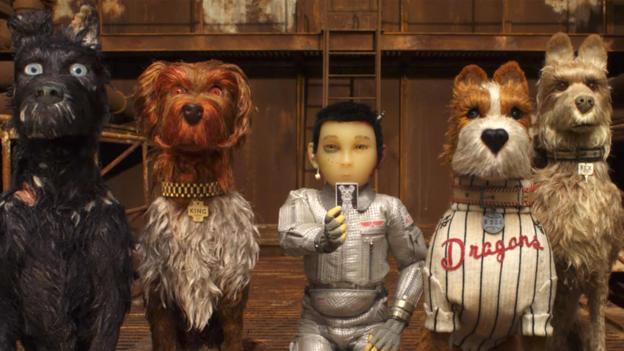
Cat lovers: you might not warm to this film. Felines haven’t been quite so synonymous with villainy since Blofeld proved himself a fan in From Russia With Love. Though cats don’t feature as characters in Wes Anderson’s Isle of Dogs, their owners are hell bent on creating a world without canines, and even Hello Kitty kitsch becomes sinister as Mayor Kobayashi, the corrupt leader of Megasaki City, tries to cleanse his dominion of dogs.
Tilda Swinton is a dog named Oracle because she can understand the TV weather forecast
Anderson’s second stop-motion animation is set in Japan in the near future. Canine saturation has reached epidemic proportions, dog flu is terrifying the humans of Megasaki, and its Mayor orders the round up and imprisonment of all dogs on nearby Trash Island – the Isle of Dogs. Six months later, the 12-year-old orphan-ward of the mayor, Atari, flies and crashes a plane on the island as he tries to find his beloved pet, Spots. A pack of five starving, abandoned dogs clinging to the names of their former lives – King, Boss, Duke, Rex and Chief – join in with the search.
– Fifty Shades Freed is a total disaster
– Black Panther: The most radical blockbuster ever?
– Five stars for Daniel Day-Lewis’s final film
Wes Anderson likes his pack too, and many of them are back, in voice form, for Isle of Dogs – Bill Murray, Edward Norton, Frances McDormand and Greta Gerwig – while Jason Schwartzmann is one of a handful of co-writers who also include The Grand Budapest Hotel’s Kunichi Nomura, and who lends his voice to dastardly Mayor Kobayashi. Bryan Cranston’s gruff tones are perfect for emotionally wounded stray underdog Chief (“I bite!”) while Scarlett Johannsson is the ever frou-frou show dog Nutmeg, with lines so predictable it should spark a demand for three dimensional roles for women playing animated animals too. Koyu Rankin, a young Scottish-Canadian actor, voices Atari, and celebrated his 11th birthday at the world premiere of the film on the opening night of the Berlin Film Festival. Tilda Swinton may have the greatest cameo of her career playing a seer pug called Oracle, who can see into the future because she understands the TV weather forecast.
Best in show
Isle of Dogs emerges as a profoundly Andersonian tribute to his love of Japanese cinema, particularly to Hayao Miyazaki, co-founder of animation house Studio Ghibli, as well as the late, legendary Akira Kurosawa. The latter’s cityscapes in films like Stray Dog and High and Low have inspired Megasaki City, while Kurosawa’s longtime collaborator, Toshiro Mifune, provides a direct inspiration for Mayor Kobayashi’s face.
But Anderson is more than capable of creating his own extraordinary universe. Like his last stop-motion animation, Fantastic Mr Fox, this too has gems of whimsy – right down to adapting 19th Century traditional Japanese artwork into a futuristic dog-scape, as well as stop-motion taiko drummers and a jewel of a rubbish-dump bar made from scavenged saki bottles. Yet Trash Island is a nuclear wasteland of a rubbish dump, a graveyard for the fossil-fuel industry and old funfairs, devastated by natural disasters – clear references to more recent, traumatic Japanese history.
Call it a classic underdog story, or a boy-and-his-dog adventure, but the nudges Wes Anderson gave us about the nastier side of 1930s Europe in The Grand Budapest Hotel become a show and tell of current day problems in Isle of Dogs. It is a film about fear of the other – it’s just ‘the other’ here happen to be canines. The dogs are impounded, imprisoned on an island far away from ‘civilisation.’ A cowed and trusting population hand over hitherto beloved pets. Humans build barbed wire fences, send drones to kill and create extermination camps – for the dogs, in this case, who are labelled a danger to the population. In Megasaki City, a dictator dispenses fake news via a propaganda TV channel, while elections are rigged. It takes an angry group of young students, led by Greta Gerwig’s cub reporter character, to tenaciously uncover the truth and protest. That many First Worlders would never allow their pets to be treated in such a way in real life, but could, even unconsciously, tolerate other humans to be demonised – and what the end result of that might be – is implicit.
Isle of Dogs may provide a terrifying answer to the eternal question, “Are you a dog or a cat person?” but the idea that love should go beyond language, or species, is born out by the story of Atari and Spots, the dog he risks his life to find. The dogs all speak English, the actors mainly speak Japanese – which was not sub-titled, but Frances McDormand’s translator does most of the necessary work for the audience. And sentiments between human and dog don’t need any translation at all.
★★★★☆
If you would like to comment on this story or anything else you have seen on BBC Culture, head over to our Facebook page or message us on Twitter.
And if you liked this story, sign up for the weekly bbc.com features newsletter, called “If You Only Read 6 Things This Week”. A handpicked selection of stories from BBC Future, Culture, Capital and Travel, delivered to your inbox every Friday.
Be the first to comment